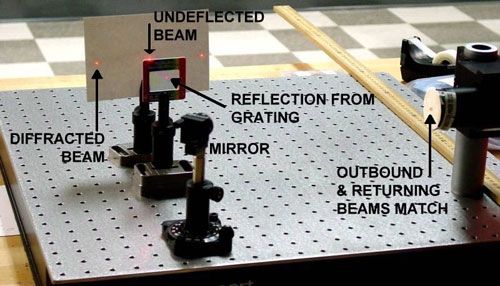Experiment of The Month
Optics Lab; Laser Wavelength
Our new optic course, physics 331, is running for the first time this fall. We will examine several of the new laboratory exercises in that course. The experiment shown below is to use a diffraction grating (mounted in a red frame in the picture) with known characteristics to measure the wavelength of the HeNe laser.

The laser on the left is one of the Newport Optics kit HeNe lasers. The mirror has two purposes:
- To direct the light beam away from other experimental groups
- To illustrate a method of meeting a requirement for simple analysis. As shown in the picture, light diffracted by a grating has its direction changed by an angle q. The angle q is given by the following equation, PROVIDED THAT THE BEAM ARRIVES ON A PATH THAT IS PERPENDICULAR TO THE GRATING. d sin q = l where l is the wavelength of the light and d is the separation between slits in the grating (the "grating spacing").
The white paper mounted on the laser has an aperture that lets the entire laser beam through. When the grating is aligned properly, the small amount of light that is reflected back from the grating surface bounces off the mirror and heads for the white paper aperture. When the grating is perpendicular to the light beam, the beam exactly retraces its steps and disappears into the aperture. This is the test used in aligning the grating perpendicular to the beam.
Students measure the distance on the screen between the diffracted beam and the
-
Contact Information
Contact Number: 717-871-4297
Email: physics@millersville.edu